Alt Trans
Bike plan push picks up speed
November 23, 2011
Los Angeles County’s new bicycle master plan, now in its final months of preparation, should be retooled to embrace more forward-looking design ideas and innovations for safer cycling on local streets, according to a motion set to go before the Board of Supervisors Tuesday.
The motion by Supervisor Zev Yaroslavsky calls on the county Department of Public Works to create a bike plan that “will not just move us out of the 1970’s, but move Los Angeles County forward as a leader in 21st Century bicyclist safety and comfort.”
Specifically, the motion says that the plan should “promote the use of leading-edge designs such as those found in the Model Design Manual for Living Streets that was prepared by the Department of Public Health.” Those include “cycle tracks” that separate bike lanes from traffic with dividers such as a lane of parked cars, and experimental street design approaches—including the possibility of varied lane and sidewalk widths in some areas—that do not fall within current Caltrans standards.
The motion urges the county to take the lead in helping such street layouts receive state approval for broader implementation.
If approved, the motion would not mandate such innovations at any particular locations, but would require that they be placed in the plan as options.
Many in the cycling community have been pushing for a bolder county bike plan, as was made clear by a series of bicycling advocates who appeared recently before the county’s Regional Planning Commission. The plan as currently envisioned would add 816 miles of new bikeways in unincorporated Los Angeles County over the next two decades, at a cost of $327.7 million. But many of those new miles fall into the lowest category of bike routes—those with just signage, no dedicated lanes or designated space within lanes.
The supervisors are expected to act on the bike plan, the county’s first since 1975, by March, 2012. But the motion makes it clear that changes need to be made before the plan’s final environmental impact report is finished in the days ahead.
“It is critical that the Board of Supervisors not wait to send a clear message that we expect this plan to do more to make the County a better, safer place to bike,” the motion said.
Posted 11/23/11
Walk this way at CicLAvia
October 5, 2011
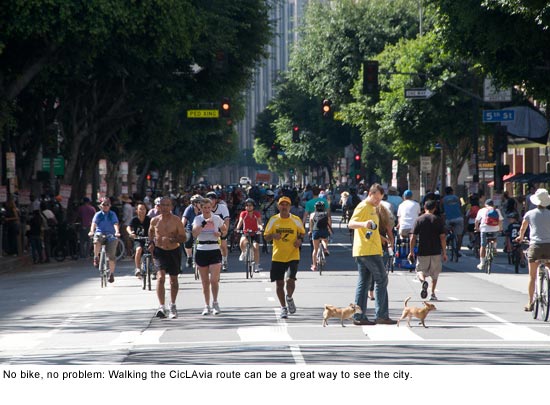 CicLAvia rolls through L.A.’s streets for the third time on Sunday, October 9, but don’t let the “cicla” part of the name fool you. Pedestrians are not only welcome—they may have the best vantage point on the route.
CicLAvia rolls through L.A.’s streets for the third time on Sunday, October 9, but don’t let the “cicla” part of the name fool you. Pedestrians are not only welcome—they may have the best vantage point on the route.
Two new segments—one running north to El Pueblo de Los Angeles and the other south through the Fashion District to the African American Firefighter Museum—bring more opportunities for street level interaction and sightseeing along the 10-mile, car-free route that stretches from the Bicycle District to Boyle Heights. Some 100,000 people are expected, so get there early (here’s how), wear comfortable shoes and come prepared to share the space with lots of bicyclists.
Joe Linton, a CicLAvia organizer, says a little eye contact and mutual respect should make sharing the street fun and safe for all.
“It’s become known as kind of a cycling event but it’s also for walking,” Linton says. “You can just go two blocks and people watch.”
Or you can do so much more: shop for a piñata, grab a bite to eat, pose in a photo booth, soak up some L.A. history, check out an iconic building shaped like a ship, and experience dozens of planned and impromptu diversions, including musical and dance performances. (Click here and here for some of the highlights.) There’s even a festival planned for those who want to sample moles, complex and savory stews cooked from authentic Mexican regional recipes.
Guided tours are being offered in Little Tokyo, Boyle Heights and an area dubbed the Spring Street Promenade downtown. For times and locations, check out this downloadable flyer, which also lists locations for some of the fixed attractions. Who could resist a solar-powered DJ or chance to cavort with what’s being billed as a “costumed colony of furry pranksters” at the Bunny Rest Stop?
And for those who want to have their bike and check it too, rest assured—CicLAvia’s free bike valets will be on hand at key points so you can drop off your wheels and join the passing promenade on foot.
Posted 10/5/11
Making sure bikes count in Los Angeles
August 24, 2011
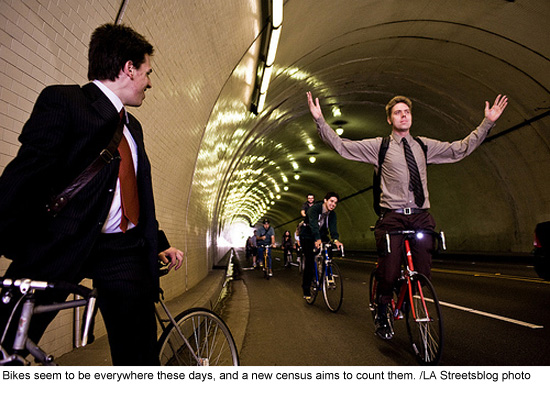
Bicycling is big in Los Angeles these days, but how many folks are actually out there using pedal power to get around? Have their ranks increased in the past two years? The Los Angeles County Bicycle Coalition hopes to learn the answers to these questions, and others, from the 2nd City of L.A. Bike Count.
The bike advocacy group is recruiting counters for 50 locations in downtown L.A., the Westside, and the San Fernando Valley. The cycle census takes place during rush hours on Tuesday, September 13 and around noon on Saturday, September 17. To volunteer, sign up online or email Martin Lopez-Iu at [email protected].
Volunteers will count bikes and record details about the riders, including gender, whether a helmet is used, if they are on the sidewalk or road and if they are observing traffic laws.
The numbers will be compared to data collected in 2009, when Los Angeles’ first bike count in twenty years recorded more than 14,000 cyclists. Survey results will be used to help city and county governments plan and develop infrastructure to make local streets more bike-friendly.
Posted 8/24/11
Metro’s orange brigade hits the rails
July 13, 2011
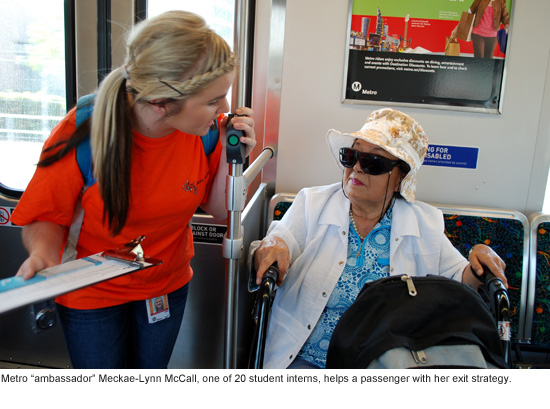 Meet Meckae-Lynn McCall, train ambassador.
Meet Meckae-Lynn McCall, train ambassador.
Although she’s just 20, and her ambassadorial appointment only lasts as long as her summer internship, she’s already got some diplomatic moves down.
There she was on an eastbound Gold Line train Thursday morning, brightly smiling as she complimented a bicyclist for stashing her ride in the correct area, and gently counseling an elderly traveler about where to exit (“The next station you’re going to want to get off…You’re very welcome, ma’am.”)
McCall is part of a new Metro summer program in which teams of student interns are jumping aboard trains and approaching customers at stations to spread the word that bikes—as well as wheelchairs, suitcases and other large items—now have a designated place on Metro trains.
Enforcers they’re not. Rather, the train ambassadors’ role is to “catch people being good,” said Alice Tolar, a Metro transportation planning manager who is overseeing the program.
“If I see you standing with your bike in the appropriate area, I’m going to thank you for that…We’re also letting non-cyclists hear what’s going on,” she said.
In addition to reinforcing good behavior, the interns will be handing out brochures detailing the agency’s current bike policy: big yellow decals now mark designated spaces on trains for bikes and other large items, and train cars are being reconfigured to create more space for bikes. (Only the Red Line cars are finished so far; reconfiguring the rest will take up to 18 months.)
The intern outreach program and the train car reconfiguration are elements of a broader effort by Metro to boost ridership by increasing its bicycle-friendliness. As part of those efforts, the agency has convened a Bicycle Roundtable and sponsored recently-released studies on how cyclists are using Metro Rail and the Orange Line. (A brief summary is here.)
The new student interns—20 of them in all—will start riding the rails officially on Monday, July 11. (Look for them first at the North Hollywood and Universal Red Line stations; they’ll be the ones in the bright orange T-shirts.) Meanwhile, they’ve divided up into teams: The Invincibles, The Phixies, Team Amazing and Team Enrique.
On Wednesday morning, they took part in some enthusiastic role-playing to get the feel of their various jobs, which in addition to train ambassador include platform ambassador, platform greeter and data collector.
With some help from the program leaders, the interns created and responded to characters ranging from an insistent smoker to a rider transporting unwieldy loads of flowers.
James Reed, who played the smoker as a blind man wielding a cardboard box as a cane, drew laughs in his mock showdown with another intern, Robert Jong. “Why can’t I smoke in the train? I’m handicapped!” he said, as Jong desperately cajoled, “Sir, there’s no smoking…”
(Afterward, they agreed that the interns shouldn’t try to confront people they see misbehaving but should notify security if it seems warranted.)
They also brainstormed ice-breakers for approaching customers, including “Nice bike!” or “We’ve made room for you” or the ever-popular, “Thank you for riding Metro!” The student interns are being paid from $8 to $12 an hour, depending on where they are in their education, from high school to grad school.
Their goal is “52 stations in 20 days”—not exactly “Around the World in 80 Days,” but definitely more do-able.
For some of the students, the internship is good experience for a future career in urban planning or transportation. For others, it’s a way to start—or expand—a professional resume. Either way, it’s a paying summer job, and a chance to encounter an unmatched array of people and situations on Metro trains.
One of the train ambassadors, Fayma Ishaq, a grad student at Cal Poly Pomona, struck up a conversation with lifelong transit rider Albert Herrera aboard the Gold Line Thursday. He told her he’d once seen a baby knocked to the ground by an impatient exiting passenger. “It’s good we’re making space because we don’t want incidents like this to happen,” Ishaq told Herrera.
Elsewhere on the train, Meckae-Lynn McCall, an early education major at Harding University, got a chance to hand out one of the first brochures to cyclist Marissa Siaz, a freelance cake decorator who also works in a Pasadena school supply store and a South Pasadena pizza place.
Siaz, 21, said she generally feels comfortable taking her bike onboard the train. “I feel welcome as long as I put it where it’s supposed to go,” she said. As for the new, intern-powered outreach campaign? Couldn’t hurt, she said. “I think most people already know [how and where to put their bike] and they just don’t want to do it. Some people don’t want to leave it there.”
Photos by Supervisor Yaroslavsky’s web staff
Posted 7/8/11
Cruising the web for two-wheel news
May 17, 2011
Just in time for Bike Week L.A./National Bike Month, the Los Angeles County Bicycle Coalition has unveiled a new look for its website.
The site’s packed with news and tips, including a rundown on how to safely commute to work by bike and how to safely share the streets with motorists.
It also features downloadable bike maps, an overview of state bicycle laws and volunteer opportunities.
Even if you haven’t had a chance to take part in this year’s Bike Week L.A. festivities, another new website, Bike Beats Car, dedicated to the proposition that cycling beats driving for most urban commutes of 7 miles or less, is offering prizes to those who take part in its “bike to work challenge.”
Posted 5/15/11
Colleges making the grade with bikes
March 24, 2011
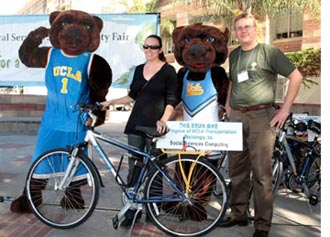 There may be no better way to keep off the dreaded “freshman fifteen” than by cycling to class, and that’s just one of the reasons that students and universities across the country are pushing hard to make their campuses more bike-friendly.
There may be no better way to keep off the dreaded “freshman fifteen” than by cycling to class, and that’s just one of the reasons that students and universities across the country are pushing hard to make their campuses more bike-friendly.
Westwood’s own UCLA is one of twenty schools nationwide that have earned a place on the inaugural “Bicycle Friendly Universities” list, recently announced by the League of American Bicyclists. Five other schools from California also earned the distinction, with Stanford University awarded the “Platinum” medal for being the most bicycle friendly university nationwide. Four of the schools on the list are part of the University of California system.
LAB is a Washington, D.C.-based group that has advocated for cyclists since their main roadway competition was the horse and buggy. Their first major effort was the Good Roads Movement of 1880, which spurred the creation of a system of paved roads that would be easier on cyclists than the existing bumpy, horse-pocked dirt roads. In doing so, they literally paved the way for the automobile. Through an ironic twist of historical fate, they now struggle against the horseless carriage for wiggle room on the very system of roads they helped to create.
LAB’s Bicycle Friendly University program represents an attempt to turn back the clock on our car-dominated culture for the sake of the future. The use of bicycles to combat gas-guzzling automobiles is gaining steam these days. L.A. County’s first Master Bike Plan in 36 years is now in the works, and the city of L.A. just approved its own plan.
LAB’s program looks at the design of the schools and surrounding community to see how bikes are physically accommodated with lanes, parking and signage. It also evaluates institutional offerings such as bike safety classes, programs and organizations that reward cycling, cooperation with law enforcement, and plans for the future.
UCLA achieved a bronze-level distinction in a city where people often accept traffic jams as an unavoidable part of daily life. Among the campus programs that helped the Bruins earn this achievement is the Bike Library, a program where students can rent a bike for the entire quarter for only $35. The program has been wildly successful, and UCLA plans to expand it in the fall. There also is an on-campus bike shop for quick minor repairs, and campus bike routes ease bike commuters in their travels.
Posted 3/24/11
Bus me out to the ballgame
March 23, 2011
Don’t get beaned by traffic this baseball season—take the Dodger Stadium Express.
Metro is providing direct bus service from Union Station to Dodger Stadium beginning with the March 28 preseason matchup with the Anaheim Angels and continuing through all 81 home games (we won’t jinx the playoffs just yet).
Game and season ticket holders ride for free; all others pay $1.50 each way. Rides will depart every 10 minutes in the 90 minutes pre-game, and every 30 minutes throughout the game and for 45 minutes after the final out.
The Dodger Stadium Express, now in its second year, is funded by the Mobile Source Air Pollution Review Committee (MSRC), a group dedicated to reducing motor vehicle air pollution along the SoCal coast.
New to the program this year, Metrolink is providing special late trains for night games. They depart from Union Station at 11 p.m. to Ventura County, San Bernardino County, and the Antelope Valley. The cost of the Metrolink trains ranges from $8 to $10 depending on how far you need to go.
Take the express bus on game day and you will save on parking as well as gas. General parking at the Stadium starts at $15 per car. Consider planning your whole excursion with Metro so you can focus on other things, like how you’re going to digest all those Dodger Dogs.
Posted 3/24/11
Sign of the times for L.A. cyclists
June 30, 2010
Shhh. The sharrows are here.
But don’t look for any big official explanation of the shared bicycle-automobile lanes that have started popping up over the past month on Los Angeles city streets. Although the topic’s been a hot one among local cycling activists and bloggers, city transportation officials say they are trying to keep a low profile for the pilot project until they can study how motorists react to the new lanes.
Even without officially-announced guidelines, people driving or biking over the new stenciled markings on L.A. streets will almost certainly notice they’re seeing something different on the road this summer. What’s less clear is whether they’ll know what the markings mean.
The sharrows—short for “shared-use arrows”—are not intended to replace bike lanes, but to provide a safe bike and car zone on streets that are too narrow for a dedicated bikes-only space. They’re meant to create a place for cyclists to ride out of the dreaded “door zone”—where a parked car door can open suddenly and knock a rider to the ground. Sharrows also remind motorists that the streets are for bicyclists’ use, too. The sharrows don’t change existing rules of the road; when passing a bicycle, motorists would continue to follow the guidance of the DMV driver handbook, which says: “Slow down and pass only when it is safe. Do not squeeze the bicyclist off the road.”
Sharrows are the latest visible sign of the bicyclization of Los Angeles—a movement that is gaining traction in a city known worldwide for its love of, and dependence on, cars.
Despite the stealth rollout, the sharrows’ arrival marks an important moment in L.A.’s transportation evolution, some bike activists say.
“Because L.A. has been historically—and still is—not bike-friendly, and is such a car culture, it really is saying, ‘Yes, we’re going to think about bikes now.’ It is the start of a turning point,” says Aurisha Smolarski, campaigns and communications director for the Los Angeles County Bicycle Coalition.
It’s a turning point that city transportation officials prefer not to discuss publicly until they can complete a study designed to evaluate motorists’ before-and-after behavior in the sharrows zones. The agency does, however, have an announcement about the new sharrows on its main website, with a link to a detailed story and pictures on its bike blog.
Smolarski’s organization, a nonprofit advocacy group that lobbied for the sharrows, has been charged with rolling out an educational effort in August or September, once the city Department of Transportation study is complete.
“Personally, I wish we could do it immediately,” Smolarski says. Instead, informative brochures must take a back seat to word-of-mouth communication for the moment.
(Meanwhile, Long Beach, which beat Los Angeles to the punch with its own sharrows, offers some neighborly help to navigating such lanes in this Q and A, posted under the headline “There’s a new sharrow in town.”)
L.A.’s first sharrows—also known as shared lane markings—were stenciled onto Fountain Avenue between Western and Vermont avenues on June 11. In addition to the coverage on the LADOT Bike Blog, the sharrows also drew the attention of KNBC, which televised this report.
After that, sharrows-sightings turned into something of a popular sport, with wags on Twitter likening it to celebrity-spotting after sharrows popped up on 4th Street between Wilton Place and Commonwealth Avenue.
Next up was Reseda Boulevard, where sharrows were stenciled between Vanowen and Valerio streets.
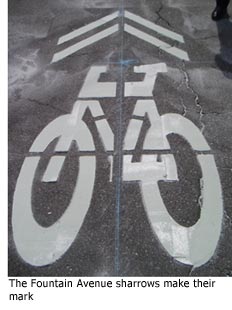 In all, six sharrows are planned for the pilot program. There’s no official word on where the others will be, but the LADOT Bike Blog has linked to the L.A. Eco-Village Blog for some information shared by a city bicycle advisory committee member on where the other sharrows are to be located, along with a Google map depiction.
In all, six sharrows are planned for the pilot program. There’s no official word on where the others will be, but the LADOT Bike Blog has linked to the L.A. Eco-Village Blog for some information shared by a city bicycle advisory committee member on where the other sharrows are to be located, along with a Google map depiction.
Sharrows have drawn kudos—and sometimes controversy—in other cities. Since they first were introduced in Denver in the mid-1990s, they’ve been used in Portland and San Francisco as well as a number of Southern California cities, including Glendale, Pasadena and Hermosa Beach, in addition to Long Beach. In June, 2006, they were stenciled on Charles Young Drive, which circles the perimeter of UCLA.
“We have ‘em. We like ‘em. They’ve been successful here,” says Dave Karwaski, UCLA’s planning and policy manager for transportation.
But they’re not universally popular. In addition to motorists concerned about losing road space they’d thought of as theirs exclusively, some fear dangerous encounters between cars and bikes traveling at different speeds on busy thoroughfares. Others worry that local governments will champion sharrows at the expense of other, more costly bicycle improvements, like dedicated bike lanes. And there has been criticism of how the markings have been placed, like in this blog that appeared after the Fountain Avenue sharrows went in. (The Los Angeles County Bicycle Coalition recently wrote an open letter to LADOT general manager Rita Robinson, providing recommendations on sharrows placement.)
Among cyclists, though, perhaps the biggest complaint is how long it all took. A small group of activists, including Smolarski, first proposed the project about five years ago, thinking it would be a quick way to make the city friendlier to bicycles.
On that front, “we were very wrong,” says Smolarski. After several years of trying to push the project forward, it finally took the L.A. City Council and its president, Eric Garcetti, to get things rolling, Smolarski and others say.
Sharrows are likely to be recommended for some streets in unincorporated Los Angeles as part of the new L.A. County Bicycle Master Plan, which is now being drafted.
Matt Benjamin, project lead for the county plan, was one of the activists who first tried to sell the city on doing a sharrows project. He said it’s a “positive development” that the pilot project is now underway in L.A. “Hopefully, they’ll explore new and creative ways of doing shared lane markings in Los Angeles,” Benjamin said, citing Long Beach’s award-winning Green Lane approach to sharrows in Belmont Shore.
Colin Bogart, another of the activists who now is working with the city of Glendale to improve cycling conditions there with the help of a PLACE grant from the county Department of Public Health, says he takes satisfaction in seeing the Fountain Avenue sharrows near his home.
“To finally see paint on the street, I’m excited about it,” Bogart says. “I’m glad that it’s finally being done, and I think that it’s just a start…The city of L.A.—if it’s serious about solving their transportation problems—is going to have to incorporate bikes.”
Posted 6/30/10
A bike week to remember
May 13, 2010
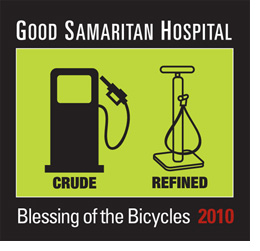 If you had any doubt that bicycle culture is on a major roll in Los Angeles, just check out the lineup for Bike Week 2010.
If you had any doubt that bicycle culture is on a major roll in Los Angeles, just check out the lineup for Bike Week 2010.
Among the attractions next week are prizes and giveaways, Tuesday’s annual nondenominational Blessing of the Bicycles outside Good Samaritan Hospital, a Downtown LA Bike Ride starting and ending at Olivera Street on Wednesday and free transit rides for cyclists on Bike to Work Day Thursday.
If that’s not enough, you also can pick up (or download) a copy of a brand new Metro map showing more than1,200 miles of local bikeways.
“Combining bus or rail with bicycling trips helps to further reduce carbon emissions and promotes a greener, better LA, “ according to Cosette Stark, Metro’s director of regional communication programs.
Metro’s blog The Source has a good rundown of the festivities here.
Posted 5-13-10




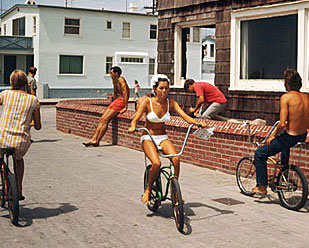















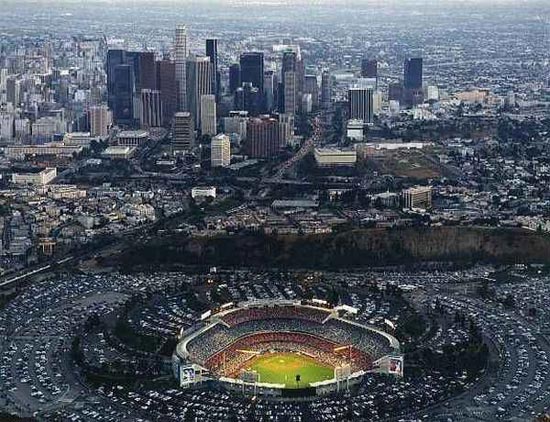
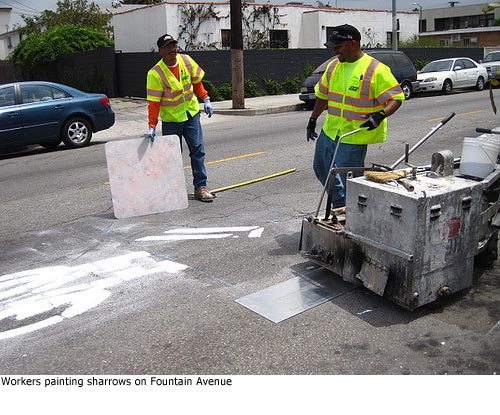
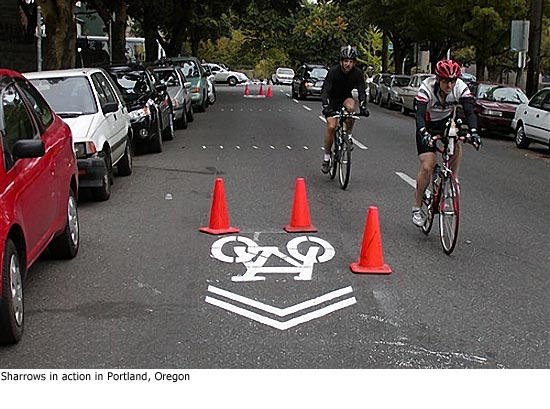







 405 bridge work causes a stink
405 bridge work causes a stink

